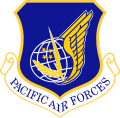497th Combat Training Flight  | |
|---|---|
 A 497th F-4E Phantom II over Korea in 1986 | |
| Active | 1942–1944; 1953–1974; 1978–1989; 1991–present |
| Country | |
| Branch | |
| Role | Combat Training |
| Part of | Pacific Air Forces |
| Garrison/HQ | Paya Lebar Air Base, Singapore |
| Nickname | Night Owls |
| Mottos | Train Hard, Fight Easy |
| Decorations | Presidential Unit Citation Air Force Outstanding Unit Award with Combat "V" Device Air Force Outstanding Unit Award Vietnamese Gallantry Cross with Palm |
| Insignia | |
| 497th Combat Training Flight emblem [a] [1] |  |
| 497th Tactical Fighter Squadron emblem [b] [1] |  |
| Patch with 497th Fighter-Interceptor Squadron emblem [c] [2] |  |
| 497th Fighter-Bomber Squadron emblem |  |
The 497th Combat Training Flight is a United States Air Force unit stationed at Paya Lebar Air Base, where its mission is to provide operational and logistical support to United States Air Force aircraft deployed to Singapore for training exercises with the Republic of Singapore Air Force.
Contents
- Mission
- History
- World War II
- Cold War air defense
- Vietnam War
- Tactical fighter operations in Korea
- Current operations
- Lineage
- Assignments
- Stations
- Aircraft
- Awards and campaigns
- See also
- References
- Notes
- Bibliography
- External links
The squadron was first activated in 1942 as the 302nd Bombardment Squadron and served as a training unit for single engine bomber crews, and later as the 497th Fighter-Bomber Squadron, for fighter pilots until being disbanded in 1944 in a general reorganization of Army Air Forces training units.
It was reconstituted in 1953 as the 497th Fighter-Interceptor Squadron and served as an air defense unit in the western United States until 1958, when it moved to Spain, where it performed the same mission until 1964. After returning to the United States as a paper unit, it began to train and reorganize with McDonnell F-4 Phantom IIs as the 497th Tactical Fighter Squadron. In December 1965, it moved to Thailand and began combat operations. In 1968, the squadron became a specialized night Fast Forward Air Control unit. It continued in combat until the summer of 1973, earning three Presidential Unit Citations. As the United States withdrew forces from Thailand, it was inactivated in September 1974.
From 1978 to 1988, the squadron was again active with F-4 Phantoms in South Korea. It was activated in its current role in 1991 as the 497th Fighter Training Squadron.










